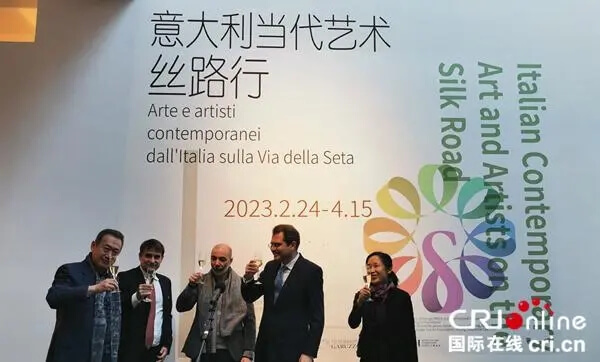
An Italian contemporary art exhibition at the Grand Tang Mall, an enchanting scenic area in the historic Chinese city of Xi’an, has attracted visitors for the past month.
The touring exhibition, “Italian Contemporary Art and Artists on the Silk Road,” closed on Sunday after 37 days at the Xi’an Art Museum in the scenic area, having welcomed over 60,000 people.
“It is like traditional Chinese culture and modern Western art communicating with each other in the same block, making the exhibition a captivating journey that transcends time and space,” said Zhang Yin, an art enthusiast from Beijing.
What makes the exhibition unique is its tour route. According to its curator, Angela Tecce, the exhibition began in Italy, the end point of the ancient Silk Road. It has toured several countries and regions along the route, including Türkiye and Uzbekistan, and finally landed in China’s Xi’an, the starting point of the Silk Road.
The exhibition’s tour to China can be read as a message of renewal and a fresh beginning, in which art confirms itself as a true facilitator for dialogue, said Pasquale Terracciano, director general for public and cultural diplomacy at the Italian Ministry of Foreign Affairs and International Cooperation, in a preface to the display.
The cultural communication between China and Italy can be traced back to ancient times. In the Western Han Dynasty (202 BC-25 AD), Chinese envoy Zhang Qian began his journey to the West via Central Asia, and opened up a trade route that later became the Silk Road.
Originally a setting for commercial exchange, it evolved into a crossroads of different cultures. More than 700 years ago, the Italian merchant and explorer Marco Polo traveled to China on the ancient Silk Road. Chinese culture had spread to the Italian Peninsula through the trade of silk, tea and porcelain, and Roman architecture and art had also spread to China. In recent years, the Xi’an Art Museum has been working closely with its peers in Italy.
In 2018, it held the exhibition “Beyond the Wall: Xi’an Contemporary Art Exhibition” in Florence, Italy, and it was well-received by locals. Both China and Italy boast long histories. Since visual art needs no translation, the exhibition can serve as a carrier for direct dialogue between classical and contemporary art, and between East and West, said Yang Chao, curator of the Xi’an Art Museum.
A total of 31 art pieces from 33 emerging Italian artists and established masters were on display at the exhibition. The artists utilized a variety of creative methods to manifest Italy’s latest artistic developments, from the 1960s to the present day. Exhibits ranged from paintings and photography to sculpture and installation. One of the artworks, “What holds it all together,” drew many visitors.
Made from porcelain and organic glass, it was inspired by the porcelain from the royal palace of Naples, demonstrating the then-popular artistic genre known as chinoiserie. “The touring exhibition was vital to cultural exchange and the formation of consensus between the peoples of China and Italy in today’s turbulent world,” Yang said.











